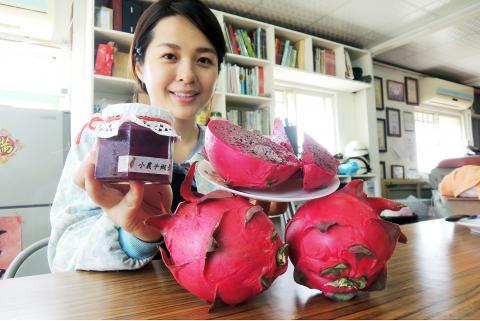The amount of land devoted to growing dragon fruit in Taitung has been gradually increasing year-on-year, and dragon fruit has become one of the emerging industries in Taimali Township. Twenty-eight-year-old Chan Chi-hsuan returned home to help her parents plant dragon fruit and develop jam, ice pops and other processed products, hoping to sustainably develop Taimali Township’s dragon fruit industry.
About 10 years ago, Taimali Township experienced a dragon fruit boom. As the species of dragon fruit at the time was relatively less sweet, and planting technology poor, farmers gave up planting them within a number of years. However, as the nutritional value of dragon fruit is well received, the past two years have shown a significant increase in the acreage devoted to growing them. Chan, who originally worked in Kaohsiung, found her parents overwhelmed with work and decided to go home last year to start studying about dragon fruit from scratch.
Chan said the crops her parents planted included piper betle and sugar apples, and they started planting dragon fruit three years ago but could not find any workers to help with the work. Also, Chan’s father suffers from diabetes and is often so busy that he is unable to normally eat three meals a day. After returning home, “at least my parents can eat meals at ease,” she said.

Photo: Chang Tsun-wei Liberty Times
照片:自由時報記者張存薇
Chan said Taimali is the place with the longest period of sunshine in all of Taiwan, and has a sea breeze that brings sodium ashore, both of which are beneficial to the quality of dragon fruit. However, since the scale of production yield in Taiwan is too high, Chan has realized the trend of falling prices, and started to develop secondary products like jam and ice pops, hoping that traditional agriculture can be upgraded into second or third-tier industries. Chan also has future plans of combining local specialties, such as millet, catjang peas and Formosa lambsquarters to launch handmade soaps.
(Liberty times, translated by Zane Kheir)
台東紅龍果種植面積逐年增加,成為太麻里鄉新興產業之一。廿八歲的詹騏瑄返鄉協助父母栽種紅龍果,研發果醬、冰棒等加工產品,希望讓太麻里鄉紅龍果產業永續發展。
太麻里鄉約十多年前曾有一股紅龍果風潮,當時因為品種較不甜、栽種技術不佳,所以沒幾年農友就棄種。因紅龍果富含營養受歡迎,這兩年種植面積大增,原本在高雄工作的詹騏瑄看到父母的辛苦,去年返鄉,從頭學起。
詹騏瑄說,父母原本種的包括荖葉、釋迦,三年前開始種紅龍果,請不到工人幫忙,父親又有糖尿病,常忙到無法正常吃三餐,回家後「爸媽至少可以好好吃頓飯」。
詹騏瑄說,太麻里是全台灣日照最長的地方,也有海風吹拂帶來鈉離子,紅龍果品質佳,但因全台灣產量太多,看到價格下滑趨勢,開始研發果醬、冰棒的副產品,希望讓傳統農業能升級為二、三級產業,未來還計畫結合在地特產小米、樹豆、紅藜等,推出在地農產手工皂。
(自由時報記者張存薇)

A: Apart from the musical Sunset Boulevard, Japanese pop diva Ayumi Hamasaki is also touring Taiwan after a 17-year wait. She’s holding two concerts starting tonight. B: Ayu has the most No. 1 hits of any Japanese solo artist, with 33 total. A: “Time” magazine even crowned her as “The Empress of Pop.” B: She staged shows in Taipei back in 2007 and 2008, causing an “Ayu fever” across Taiwan. A: Unfortunately, the singer has been deaf in her left ear since 2008, and is gradually losing hearing in her right ear. I’m so excited to see her singing in Taipei again. A: 除了音樂劇《日落大道》,日本歌后濱崎步睽違17年,今晚起在台北熱唱兩場。

Thailand and Cambodia are engaged in their worst fighting in over a decade, exchanging heavy artillery fire across their disputed border, with at least 30 people killed and tens of thousands displaced. Tensions began rising between the Southeast Asian neighbors in May, following the killing of a Cambodian soldier during a brief exchange of gunfire, and have steadily escalated since, triggering diplomatic spats and now, armed clashes. WHERE DOES THE DISPUTE ORIGINATE? Thailand and Cambodia have for more than a century contested sovereignty at various undemarcated points along their 817km land border, which was first mapped by France in 1907 when Cambodia was

Alan Turing, celebrated as the “father of computer science,” was a brilliant mathematician and scientist. Born in London in 1912, Turing showed exceptional talent in mathematics and science from a young age. At 16, he understood Albert Einstein’s work without difficulty. This intelligence carried him through studies at Cambridge University and later at Princeton University in the US, where he further explored complex mathematical theories. In 1936, Turing introduced the concept of the Turing machine, a theoretical device for solving mathematical problems. He described it as having an infinite tape on which symbols could be read, interpreted, and modified. With simple

A: After touring Taipei, the play Life of Pi is now heading to Taichung. You wanna go? B: Did you forget? We’re going to Taipei this weekend to see the musical Sunset Boulevard and go to Japanese pop diva Ayumi Hamasaki’s concert. A: Oh yeah, that’s right. The classic composed by Andrew Lloyd Webber is touring Taiwan for the first time. B: I heard that it’s adapted from a 1950 film with the same title. A: And the show will feature legendary soprano Sarah Brightman, who is finally returning to the musical stage after 30 years. We can’t miss it. A: 在台北巡演後,戲劇《少年Pi的奇幻漂流》本週起將移師台中。要去嗎?